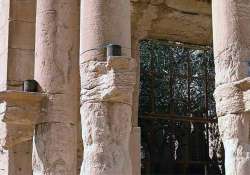Islamic State damages ancient temple in Syria's Palmyra
Beirut: Islamic State militants in Syria severely damaged the Bel Temple, considered one of the greatest sites of the ancient world, in a massive explosion Sunday, activists said.The 2,000-year-old temple was part of the remains

Beirut: Islamic State militants in Syria severely damaged the Bel Temple, considered one of the greatest sites of the ancient world, in a massive explosion Sunday, activists said.
The 2,000-year-old temple was part of the remains of the ancient caravan city of Palmyra in central Syria, seized by IS in May.
The news of the latest destruction at Palmyra came just days after IS released propaganda images purportedly showing militants blowing up another Palmyra temple, the 2,000-year-old Baalshamin dedicated to the Phoenician god of storms and fertilizing rains.
The U.N. cultural agency UNESCO, which has designated Palmyra as a world heritage site, called the destruction of the Baalshamin temple a war crime.
Earlier this month, relatives and witnesses said that IS militants had beheaded Khaled al-Asaad, an 81-year-old antiquities scholar who devoted his life to understanding Palmyra.
The Islamic State group, which has imposed a violent interpretation of Islamic law across its self-declared "caliphate" straddling Syria and Iraq, says such ancient relics promote idolatry.
It already has blown up several sites in neighboring Iraq, and it is also believed to be selling looted antiquities.
A Palmyra resident, who goes by the name of Nasser al-Thaer, said IS militants set off a huge blast at 1:45 p.m. Sunday.
"It is total destruction," he said of the scene of the explosion. "The bricks and columns are on the ground."
"It was an explosion the deaf would hear," he added.
The resident said only the outer wall surrounding the temple remains.
The Britain-based Syrian Observatory for Human Rights, which has a network of activists in Syria, said the temple was damaged. It did not provide details.
The temple, consecrated to the Semitic god Bel, had been well-preserved and was a source of much pride for Syrians. It was consecrated in 32 A.D.
It stood out among the ruins not far from the colonnades of Palmyra, which is affectionately known by Syrians as the "Bride of the Desert."
Earlier Sunday, IS fighters pushed into a large district in southern Damascus, clashing with rival militants just a few kilometers from the center of the Syrian capital, the extremist group and Syrian activists said.
More than two dozen militants were killed in the clashes on the edges of the Qadam neighborhood, said the Observatory.
The pro-IS Aamaq News Agency reported that IS fighters seized half of Qadam. The Observatory's Rami Abdurrahman said IS fighters were holding two streets and that fighting was continuing.
IS supporters posted propaganda pictures claiming to show IS fighters advancing in the narrow streets of Qadam. The authenticity of the images could not be confirmed independently.
IS has emerged as one of the most powerful forces in the battle to overthrow Syrian President Bashar Assad. Armed Islamic factions fighting forces loyal to Assad control parts of Damascus and large parts of the city's suburbs. IS fighters control large parts of the Palestinian refugee camp of Yarmouk, east of Qadam.
Also Sunday, a mortar round hit an upscale neighborhood of central Damascus, killing four people, including a girl, Syrian state TV said.
It is not uncommon for Damascus to be shelled. Sunday's attack targeted the posh neighborhood of Abu Rummaneh, which houses hotels and several embassies.
An Associated Press reporter on the scene saw two people wounded by shrapnel. Vehicles in the area were also damaged.